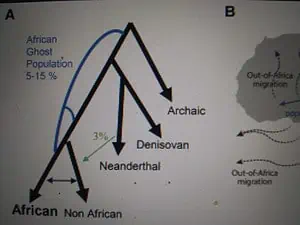Ambroise Wonkam & Adebowale Adeyemo, publish study suggesting primitive admixture in modern Africans. Dates align with Australopithecines
 Ambroise Wonkam and Adebowale Adeyemo are medical doctors, immigrants from Africa. Both have had distinguished careers at East Coast medical facilities, and have received acclaim and awards for their work.
Ambroise Wonkam and Adebowale Adeyemo are medical doctors, immigrants from Africa. Both have had distinguished careers at East Coast medical facilities, and have received acclaim and awards for their work.
Ambroise Wonkam from his bio:
Prof Ambroise Wonkam is a professor of Genetic Medicine, and Director of the McKusick-Nathans Institute, and Department of Genetic Medicine.
After an MD training from the Faculty of Medicine and Biomedical Sciences, University of Yaoundé I (Cameroon), he completed a thesis in Medical Sciences, University of Geneva (Switzerland) and a Ph.D. in Human Genetics (University of Cape Town, South Africa).
Adebowale Adeyemo from his bio:
 Dr. Adeyemo qualified in medicine at the University of Ibadan in Nigeria. After a residency in pediatrics and genetics, he became a faculty member of the College of Medicine, University of Ibadan, Nigeria and a consultant pediatrician/geneticist at the University College Hospital, Ibadan, Nigeria. He subsequently held fellowships in genetic epidemiology and in medical education. He moved to Howard University, Washington, D.C. in 2003 to work in genetic epidemiology at the National Human Genome Center at Howard University. He came to the NIH in 2008 as a Staff Scientist. He became an associate investigator at NHGRI in 2016.
Dr. Adeyemo qualified in medicine at the University of Ibadan in Nigeria. After a residency in pediatrics and genetics, he became a faculty member of the College of Medicine, University of Ibadan, Nigeria and a consultant pediatrician/geneticist at the University College Hospital, Ibadan, Nigeria. He subsequently held fellowships in genetic epidemiology and in medical education. He moved to Howard University, Washington, D.C. in 2003 to work in genetic epidemiology at the National Human Genome Center at Howard University. He came to the NIH in 2008 as a Staff Scientist. He became an associate investigator at NHGRI in 2016.
The authors studied 12 different indigenous African populations from varying regions of the continent. The study was aimed at better understanding diseases and causes of various illnesses that affect specifically Africans and ethnic Africans living in the United States and other Western countries. The paper highlights sickle-cell anemia, and Covid 19 specifically.
However, of particular interest to the paleo-anthropology community, Wonkam and Adeyemo released data from their findings that points to deeply archaic hominin DNA admixture in modern Africans and Afro-ethnics. The data echoes similar findings from past studies, most especially geneticists Durvasula and Sakaraman, UCLA genetics, 2020.
See our article here at Subspeciest, March 2020, “West Africans have 19% archaic ghost species DNA according to New UCLA genetics paper.”
Background from the BBC, Feb. 14 2020,
‘Ghost’ human ancestor discovered in West Africa
 A mysterious “ghost population” of now-extinct ancient human-like creatures may have interbred with early humans living in West Africa, scientists say.
A mysterious “ghost population” of now-extinct ancient human-like creatures may have interbred with early humans living in West Africa, scientists say.
Researchers suggest DNA from this group makes up between 2% and 19% of modern West Africans’ genetic ancestry.
They believe the interbreeding occurred about 43,000 years ago.
Scientists found links to the Mende people of Sierra Leone, Yoruba as well as Esan people in Nigeria, plus other groups in western areas of The Gambia.
Like Durvasula and Sakararaman before them, Wonkam and Adeyedo offer hints as to the identity of the hominin species responsible for the African archaic admixture. But they take it a step further giving specific dates of the three introgression events.
From Cell.com, March 8,
Leveraging our common African origins to understand human evolution and health
 The authors data suggest that all modern humans derive approximately 5%–15% of their ancestry from a lineage that may have diverged as long as 1–3 mya, with multiple introgression events (Figure 1A ), which is in line with previous reports.
The authors data suggest that all modern humans derive approximately 5%–15% of their ancestry from a lineage that may have diverged as long as 1–3 mya, with multiple introgression events (Figure 1A ), which is in line with previous reports.
Generation of high-coverage reference genomes for archaic hominid species such as Neanderthals has allowed the identification of approximately 2% introgression portion of that genome in present-day Europeans, ostensibly enriched for variation in genes involved in dermatological phenotypes, neuropsychiatric disorders, and immunological functions, including host susceptibility to coronavirus disease 2019 (COVID-19).
Continuing:
In a similar vein, Fan et al. showed evidence of 2% content from Neanderthal genomes in African populations from Ethiopia, most likely as a result of admixture with non-Africans. However, these findings should be further interrogated directly with comparative analysis of more genomes from Ethiopians and available Neanderthal genomes. The largest challenge in expanding this area of research in Africa has been the inability to obtain high-quality ancient DNA from regions with a tropical climate where the heat and humidity rapidly degrade DNA. The recent report of the successful isolation and sequencing of DNA from four children buried at Shum Laka (Cameroon) 3,000–8,000 years ago indicates that studies of ancient DNA are now possible in western Central Africa.
The citation of Shum Laka refers to well-preserved skeletons of 4 children in southeastern Cameroon. They were identified as Pygmies, Baka and Aka tribes, who later moved into central Africa in the Congo.
From ZmaScience.org, 2020,
 [They] had some DNA coming from an ancient source in West Africa — including a “long lost ghost population of modern humans that we didn’t know about before,” says population geneticist David Reich of Harvard University, leader of the study…
[They] had some DNA coming from an ancient source in West Africa — including a “long lost ghost population of modern humans that we didn’t know about before,” says population geneticist David Reich of Harvard University, leader of the study…
Wonkam and Adeyemo include a chart. From their description:
Complex demographic history of African populations consists of ancient population evolutionary divergence, including multiple introgressions of archaeid DNA within African genomes, as illustrated by a simplified demographic model indicating at least two introgression events from archaic human that never move out of Africa (blue lines).
Note – introgression is simply an academic, anthropological term meaning sexual encounters, mixing of genes.
Of particular interest to readers of this site, and to the overall right paleo-anthropology community, is the blue line. Three introgression events are cited. The first two are putative, relatively uncontroversial. Paleo-anthropologists and evolutionary geneticists generally agree that two introgression events took place with the direct ancestor of Homo sapiens 700-800,000 years ago, and 300,000 years ago.
Modern African introgression with Homo erectus, Naledi, Australopithecus sediba or other hominin?
 Note – Wonkam and Adeyemo neglect to include dates on the chart. But going by the divergence line of Homo sapiens and then Neanderthal, Denisovan, which is 490,000 years ago, it can be easily surmised that the two introgression dates are 700-800,000 years ago, and 300,000 ya.
Note – Wonkam and Adeyemo neglect to include dates on the chart. But going by the divergence line of Homo sapiens and then Neanderthal, Denisovan, which is 490,000 years ago, it can be easily surmised that the two introgression dates are 700-800,000 years ago, and 300,000 ya.
The divergence date for Africans and Eurasians is generally assumed to be 45,000 to 70,000 years ago. Some paleo-anthropologists and evolutionary geneticists have suggested as high as 90,000 ya.
The third blue line representing another introgression event comes after the divergence between Africans and Eurasians.
Note – the authors use a green line to represent Neanderthal introgression. Therefore they imply that the blue line represents the same species.
Wonkam and Adeyemo do not specify which hominin species is represented by the blue line. Homo erectus (earlier Homo ergaster), would seem to be the only hominin species to fit their criteria. Dates for Homo erectus are from 1.9 million ya to 70,000 ya. (Ref. Smithsonian). But other possible candidates could include smaller brained species such as Australopithecus sediba, Homo naledi and Homo rhodesiensis (Kabwe skull), considered likely related to Florisbad man (Florisbad skull SA).



Both authors work for, or are on long term funded projects by the NIH, and the NIH is officially censoring all access to NIH genetic research collection, to only qualified researchers, no one else can access the collection, a very unscientific, totalitarian thing to do.
I don’t see any reference to Lee Berger’s work, and he is claiming the “ghost ancestor” of present day sub-Saharan blacks is “Homo” Naledi, that in no way can be considered a extinct modern Human, as these authors are claiming that, that “ghost ancestor” is.
I’ll be rereading their work over the week end, and peruse their references, and see in more detail what this article is about.
Regardless of the identity of the ghost population, the answers are likely to be found underneath the sands of the Sahara desert.
In a post from last October, Lee Berger, John Hawks and others gushed that Homo naledi was a likely candidate as the archaic ghost species found in the genome of some of today’s West Africans:
https://subspecieist.com/archaic-hominins/lee-berger-2/
While that’s possible, there are good reasons at present to believe that conclusion is grossly premature.
First, the present dating: Berger claims naledi lived around 300,000 years ago. The geneticists here say they believe the interbreeding occurred 43,000 years ago. A quarter of a million years is a big difference.
Second, the distance: Homo naledi is known to only have lived in one place, South Africa. That’s some 4000 miles away from Western Africa.
Third, the Berger-Hawks Theory contradicts the obvious most-likely scenario that the current evidence presents. The heart of it is that at the same time naledi prospered, archaic sapiens were also in Africa. Many have pointed out, “How can naledi have lived side by side with early humans?”
The simplest answer is that they didn’t. By whatever fates of geography, ecology, migration and climate the two populations were separated at least long enough to succeed in their respective niches.
One obvious observation is that in South Africa naledi thrived a long way from the hub of the continent, at the farthest end. It seems reasonable that area might be favorable for population isolation and speciation. In such situation, a less-capable hominin could thrive by benefit of competitive sanctuary.
Whatever archaic population contributed to the West African ancestry, by definition it had to have been an isolated population if this happened only 43,000 years ago.
It’s become increasingly apparent over the past couple of decades that retrogressed hominin pockets were common. It’s a major reason that perfectly tracing the Homo family tree is impossible.
It is a maxim of paleoanthropology that given enough time between discoveries the latest greatest find resets the entire hominin paradigm, especially if you hear the founders tell it.
But picking Homo naledi far from time and far from home as that one particular West African critter in this one particular case is a stretch way beyond the evidence we have today.
A more probable culprit would most likely be found in the archaic hominin hub of Africa presently occupied by the Sahara. At the late date indicated, the likelihood that it was a “lost world” bunch of australopithecines seems slim.
Homo heidelbergensis is thought by some to have been a common ancestor, perhaps the last common ancestor, before archaic sapiens and neandertalensis split and went their separate ways.
It is not unreasonable to wonder whether some kind of isolated population of evolved heidelbergensis survived somewhere in upper Africa, interbred with modern humans they encountered, and became extinct as a species under competitive pressure some 40,000 years ago.